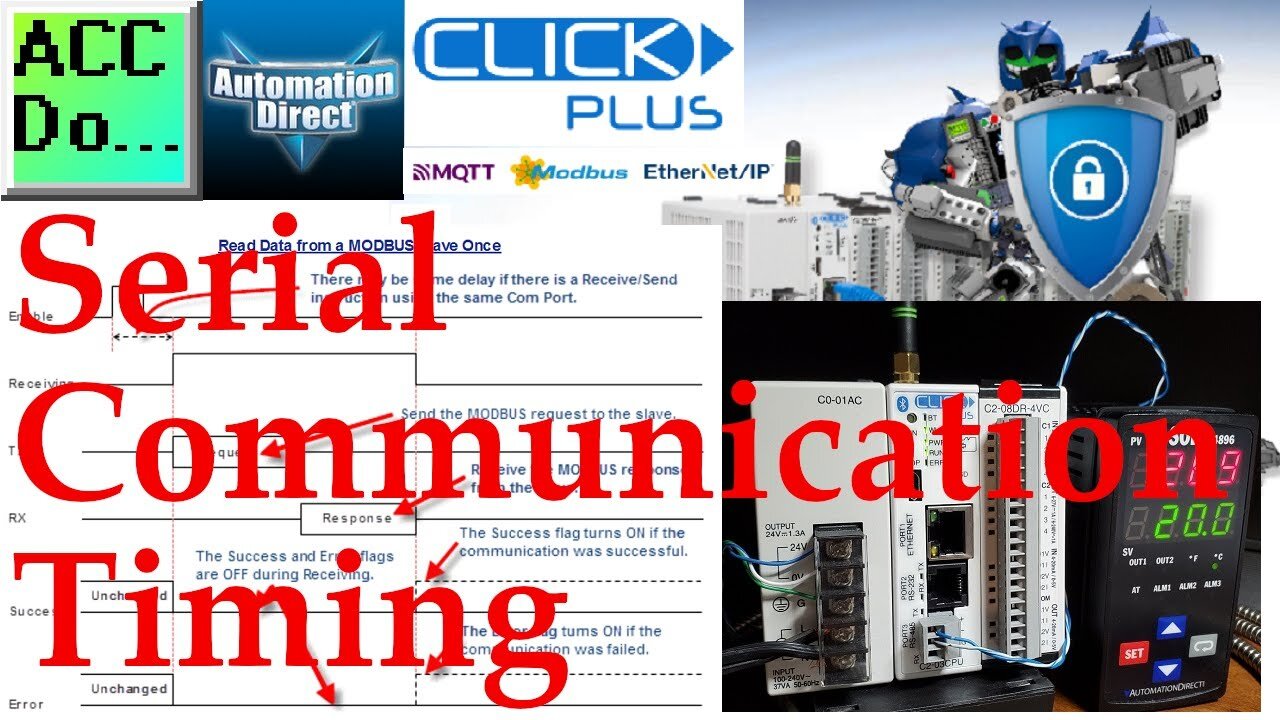Premium Only Content

Click PLC Serial Communication Timing
Many questions come from serial communications using the Click PLC. Most of these questions deal with communication timing when using multiple send and receive instructions. We will show you how to deal with serial communication timing in the Click PLC.
Receive and Send instructions will allow you to send and receive serial data to an external device. The communication method that you set up can be ASCII or Modbus. ASCII (American Standard Communication for Information Interchange) can be used to send to devices such as a printer. Receiving ASCII can be used for connecting barcode scanners to the PLC. The barcode will be read as an ASCII string in the PLC. Modbus serial communication (Modbus RTU) is a standard protocol used in many automation devices.
We will demonstrate the Send and Receive instruction by communicating Modbus RTU to a Solo Temperature Controller. Parameters from the Solo process temperature controller will be read using multiple receive instructions. The send instruction will be used multiple times as well to set the Set Value (SV) and Limits of the SV value entered in the temperature controller. The set values will only be changed when required. Let’s get started.
Features of the new Click PLUS PLC (C2-0xCPU) includes the following:
• Micro USB
• DHCP support
• DNS support
• Wi-Fi (programming and Modbus TCP)
• Bluetooth (Wi-Fi) provisioning
• SD Card (Data Logging)
• Data Logger
• Network Time Service
• MQTT (Publish/Subscribe)
• Required PLC Password
• Disable Ports
• Strong Password Support
• Disable Ping Response
• Encrypted Password Transfer
More information can be obtained at our website. This includes all of the links mentioned in this video.
https://accautomation.ca/click-plc-serial-communication-timing/
00:00 Click PLC Serial Communication Timing
01:47 Click Solo Hardware - Serial Wiring
02:28 Solo Temperature Controller RS485 Setup
03:25 Click PLC RS485 Setup
04:02 Slave Modbus Addresses
04:41 Click PLC Serial Port Programming
10:03 Testing the Click to Solo Communication Program
Previously we looked at the following:
Click Plus Software Installation
https://accautomation.ca/click-plus-software-installation-version-3-00/
https://youtu.be/6uQQzyZ-O3s
Establish Communication
https://accautomation.ca/click-plus-establish-communication/
https://youtu.be/1Bnx3IROCqk
MQTT Communication
https://accautomation.ca/click-plus-plc-mqtt-communication/
https://youtu.be/wzUBolN9KjQ
Data Logging
https://accautomation.ca/click-plus-data-logging-csv-file-sql-database/
https://youtu.be/ydoWvMzHSKc
Click Plus Real-Time Clock
https://accautomation.ca/click-plus-real-time-clock-setup-and-use/
https://youtu.be/0Vlqo8p0vCI
CLICK PLCs were designed with simplicity in mind, providing reliable control at a low, low cost and with little to no learning curve.
This simplicity makes CLICK a perfect solution for small machines, home automation projects, pneumatic applications, or anywhere a simple system needs a budget-saving control solution.
Building on the original CLICK’s simple design, the new CLICK PLUS PLCs offer the same practical control but with some surprising bells and whistles. Using the same FREE, streamlined PLC programming software as its predecessor, the CLICK PLUS PLCs provide no-headache programming combined with advanced capabilities like Wi-Fi communication and data logging.
The Click and Click PLUS PLC series can be found at this URL:
https://accautomation.ca/series/click-plc/
There are several reasons why we are using the Click and Click PLUS PLCs. Here are just a few.
- Investment is low for the hardware and the software is free
- Standalone PLC with built-in I/O
- Communication ability - Ethernet Port, RS232, RS485 - support for protocols such as Modbus RTU, Modbus TCP, etc.
- Ability to expand the system with a variety of modules including RTD and Thermocouple inputs directly.
-
 1:04:03
1:04:03
TheCrucible
3 hours agoThe Extravaganza! EP: 64 (11/24/25)
75.9K6 -

Kim Iversen
2 hours agoIsrael Running The Dept Of Homeland Security Social?!?
16.2K38 -
 LIVE
LIVE
Akademiks
1 hour agoSheck Wes exposes Fake Industry. Future Not supportin his mans? D4VD had help w disposing his ex?
940 watching -
 DVR
DVR
The Trish Regan Show
2 hours agoJUST IN: ABC HIRES Marjorie Taylor Greene for ‘The View’?! Hosts FREAKING OUT Over Being REPLACED!
14.1K4 -
 22:02
22:02
We Got Receipts
6 hours agoIt just got WORSE for Democrats…
6.58K3 -
 4:15
4:15
Captain Peach
9 days ago $0.53 earned5 Ways Games Trick You Into Buying
6.72K1 -
 1:00:30
1:00:30
Based Campwith Simone and Malcolm
4 days agoYou Think You Hate The Media ... You Don't Hate Them Enough
6.79K1 -
 LIVE
LIVE
The Amber May Show
4 hours agoAmerica’s Spiritual Shake-Up: From Pews to Paganism?
82 watching -
 1:16:27
1:16:27
Redacted News
3 hours agoYou Won't BELIEVE what is happening in America right now... It's SHOCKING
113K107 -
 1:38:07
1:38:07
vivafrei
4 hours agoLive with Ivan Raiklin! Jan. 6 Pipe Bomber~! Comey & Letitia James Charges Dropped! AND MORE!
78.9K47